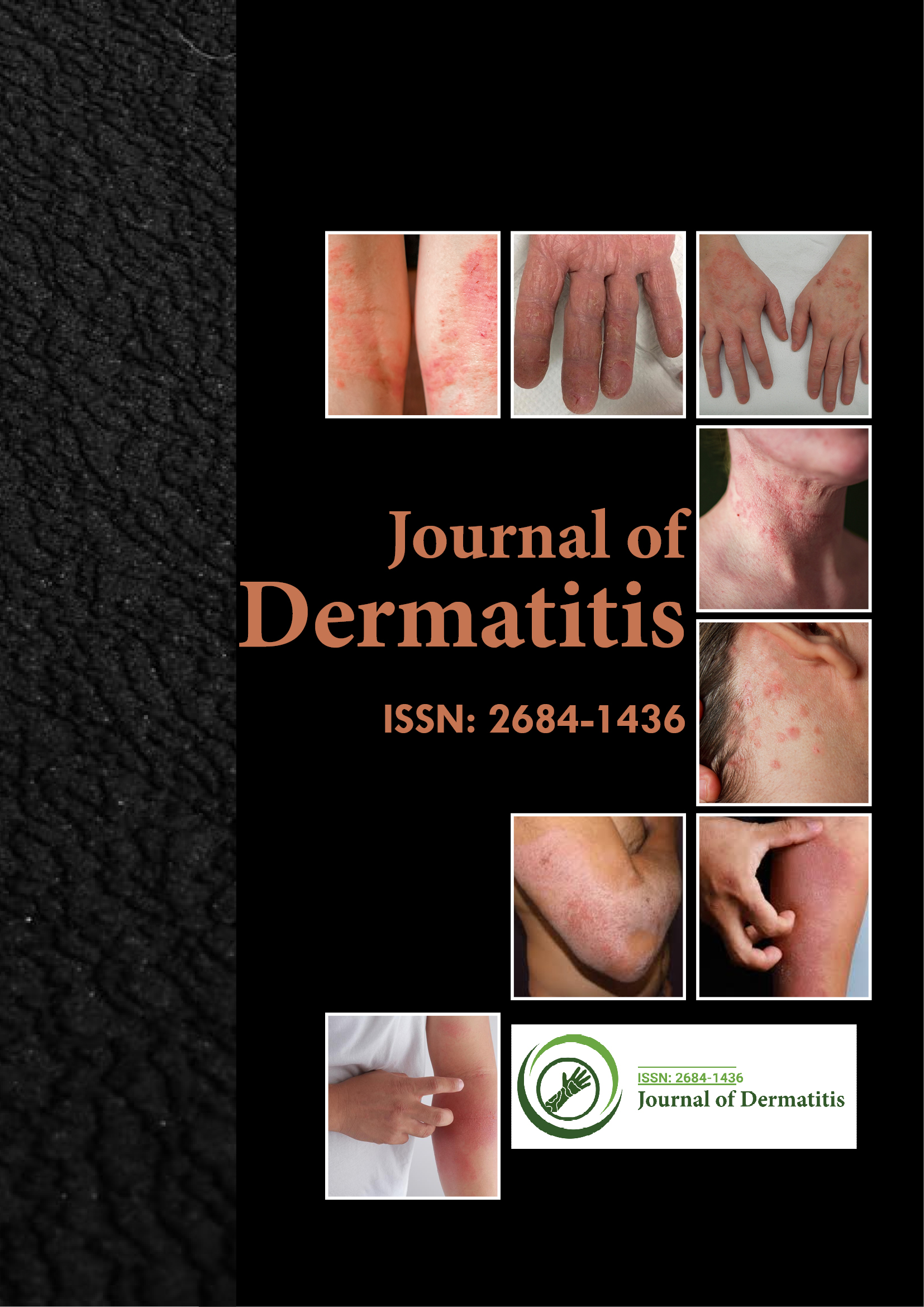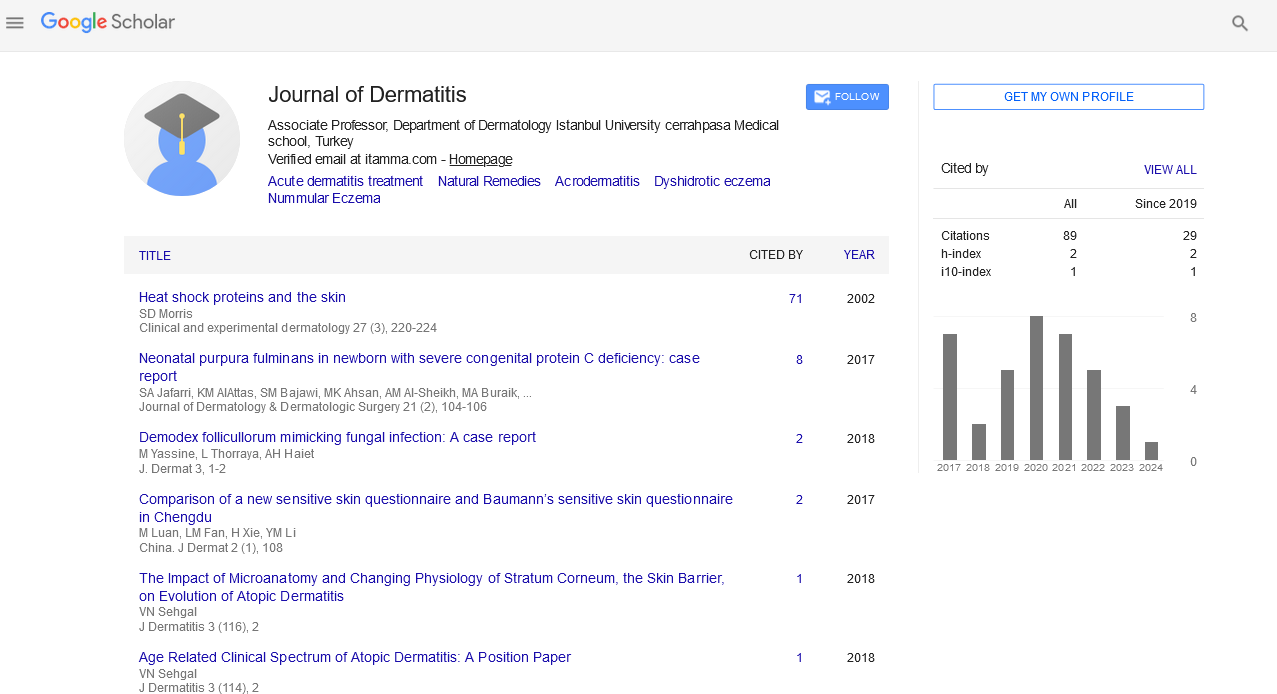Indexed In
- RefSeek
- Hamdard University
- EBSCO A-Z
- Euro Pub
- Google Scholar
Useful Links
Share This Page
Journal Flyer

Open Access Journals
- Agri and Aquaculture
- Biochemistry
- Bioinformatics & Systems Biology
- Business & Management
- Chemistry
- Clinical Sciences
- Engineering
- Food & Nutrition
- General Science
- Genetics & Molecular Biology
- Immunology & Microbiology
- Medical Sciences
- Neuroscience & Psychology
- Nursing & Health Care
- Pharmaceutical Sciences
Commentary - (2022) Volume 7, Issue 1
Evaluation of Skin Toxicity of Silver Nanoparticles in 3D Epidermal Model Compared to 2D Keratinocytes
Shawn Kwatra*Received: 05-Jan-2022, Manuscript No. JOD-22-15519; Editor assigned: 07-Jan-2022, Pre QC No. JOD-22-15519; Reviewed: 21-Jan-2022, QC No. JOD-22-15519; Revised: 26-Jan-2022, Manuscript No. JOD-22-15519; Published: 26-Jan-2022, DOI: 10.35248/2684-1436.22.7.144.
Introduction
The increasing use of nanotechnology to manufacture consumer products raises concerns about the safety risks associated with exposure to nanomaterials. Silver nanoparticles (AgNPs) are one of the most commonly used nanomaterials due to their excellent broad-spectrum antibacterial properties. Colloidal silver particles are found in many industrial and medical products such as textiles, food packaging, water disinfectants, implant coatings, catheter coatings and wound dressings. Silver nanoparticles are reported as a component of 30% of products containing nanomaterials. However, AgNP can be toxic. Therefore, it is essential to accurately assess the potential risks associated with the administration of AgNP.
The toxicity of AgNP has been extensively studied over the last few decades. Most studies used two-dimensional (2D) cell culture models or animal models to assess toxicity. However, few studies have used three-dimensional (3D) tissue models. The use of 2D monolayer cultures consisting of immortalized cell lines, stem cells, or primary cells is the most common method for assessing toxicity in vitro. The cell type depends on the proposed use of nanomaterials and the expected target organs in vivo. Two-dimensional cell cultures are easy to use for biochemical assays. However, 2D culture lacks cell-cell and extracellular matrix interactions and lacks barrier function. Therefore, current 2D cell culture models are generally unable to mimic the skin microenvironment in vivo and therefore provide limited information about the organism’s physiological response to external stimuli such as nanoparticles.
According to studies, in vitro and in vivo data are often poorly correlated. Therefore, care must be taken when generalizing in vitro results to in vivo effects. In recent years, some new drugs have been excluded from preclinical studies because in vitro toxicity studies failed to detect the risks associated with these drugs. In vivo studies are usually performed with a series of doses based on the results of in vitro experiments or actual doses, which may lead to more reliable results. However, animal use can be a limiting factor in determining toxicity for cost, biosafety, and animal ethics. To reduce the gap between in vitro and in vivo, there is a strong need for a new in vitro model system that can be used to accurately predict in vivo toxicity. The ideal model would assess the adverse effects of actual doses on inflammation, Reactive Oxygen Species (ROS) formation, immune system activation, etc. in vitro to accurately assess the potential risks associated with nanoparticles. You can evaluate it. Cells in the 3D tissue model, unlike cells in the 2D model, can differentiate and develop cell subsets with different functional states to form tissue structures. Three-dimensional tissue models can also simulate barrier functions that mimic the absorption and distribution of substances in vivo. Therefore, 3D models may be able to bridge the gap between in vitro and in vivo models. In vitro studies of the biological effects of nanoparticles using a 3D model system may be more appropriate than using a 2D model system, as toxicity can be affected by the cellular microenvironment. Lee et al. For the first time in 2009, we evaluated the toxicity of nanoparticles using a 3D spheroid culture-based test system. They found that the toxic effects of CdTe and Au nanoparticles were significantly reduced in spheroid cell cultures compared to 2D cell cultures. In addition, several different in vitro 3D models have been created and used to assess the biological effects of nanoparticles. These systems include a 3D cell spheroid culture system and an EpiDerm ™ tissue model.
Conclusion
The rapid development of wearable textiles and medical devices, including AgNP, raises concerns that consumers may be at increased risk of adverse health effects from skin exposure to AgNP. Previous studies have shown that AgNP induces severe cytotoxicity in cultured keratinocytes, whereas in vivo studies have shown relatively weak toxicity. Previous reports have shown that no significant toxicological changes occurred during the 28-day AgNP inhalation study in rats. In this study, we developed a 3D epidermis model called EpiKutis, which is composed of human keratinocytes (KC) that mimic human epidermis, and used it to evaluate AgNP toxicity. A two-dimensional keratinocyte culture was used as a control. Oxidative damage and inflammation were evaluated in each model.
Citation: Kwatra S (2022) Evaluation of Skin Toxicity of Silver Nanoparticles in 3D Epidermal Model Compared To 2D Keratinocytes. J Dermatitis.7:144.
Copyright: © 2022 Kwatra S. This is an open -access article distributed under the terms of the creative commons attribution license which permits unrestricted use, distribution and reproduction in any medium, provided the original author and source are credited.

